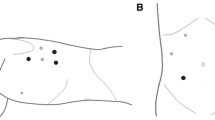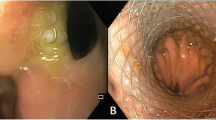Abstract
Background
Surgical treatment is usually required for Boerhaave’s syndrome (post-emetic esophageal perforation), and the technique should be chosen based on the local infection status and patient’s general condition. This study was performed to examine the current status of surgical treatment of Boerhaave’s syndrome in Japan.
Methods
Ninety-five patients with Boerhaave’s syndrome who underwent surgical treatment from January 2010 to December 2015, obtained from a national survey were retrospectively analyzed. The details of each surgical treatment and the type of treatment performed according to the patients’ characteristics were examined.
Results
Primary closure was performed in 75 (78.9%) patients, T-tube insertion in 15 (15.8%), and esophagectomy in 5 (5.3%). The length of the postoperative stay was significantly shorter in patients who underwent primary closure (p = 0.0011). Esophagectomy tended to be performed more often in patients with a long perforation and was performed significantly more often in patients with a high C-reactive protein concentration (p = 0.0118). The postoperative hospital stay was significantly longer in patients with leakage of the primary closure site (p < 0.0001). As a result, leakage of the primary closure site was significantly correlated with a long duration from symptom onset to patient presentation (p = 0.042), diagnostic imaging of the intrathoracic perforation (p = 0.013), and abscess formation in the mediastinal cavity (p = 0.006).
Conclusions
Selection of an appropriate surgical procedure may contribute to reduced mortality rates in patients with esophageal rupture. With regard to primary closure, it is necessary to understand that leaks are likely to occur in patients with a long duration from symptom onset to presentation or with severe intrathoracic/mediastinal inflammation, and to select an appropriate surgical procedure in consideration of the degree of invasiveness and QOL.




Similar content being viewed by others
References
Sohda M, Kuwano H, Sakai M, et al. A national survey on esophageal perforation: study of cases at accredited institutions by the Japanese Esophagus Society. Esophagus. 2020;17:230–8.
Sohda M, Saeki H, Kuwano H, et al. Clinical features of idiopathic esophageal perforation compared with typical post-emetic type: a newly proposed subtype in Boerhaave’s syndrome. Esophagus. 2021. https://doi.org/10.1007/s10388-020-00802-0.
Markar SR, Mackenzie H, Wiggins T, et al. Management and outcomes of esophageal perforation: a national study of 2564 patients in England. Am J Gastroenterol. 2015;110:1559–66.
Pezzetta E, Kokudo T, Uldry E, et al. The surgical management of spontaneous esophageal perforation (Boerhaave’s syndrome)—20 years of experience. Biosci Trends. 2016;10:120–4.
Janjua KJ. Boerhaave’s syndrome. Postgrad Med J. 1997;73:265–70.
Bufkin BL, Miller JI Jr, Mansour KA. Esophageal perforation: emphasis on management. Ann Thorac Surg. 1996;61:1447–51 (discussion 1451–2).
Waltersten M, Sundbom M. Patient-reported long-term outcome is superior after treatment with self-expanding metallic stents in esophageal perforations. Scand J Surg. 2020. https://doi.org/10.1177/1457496920960999.
Brinster CJ, Singhal S, Lee L, et al. Evolving options in the management of esophageal perforation. Ann Thorac Surg. 2004;77:1475–83.
Okamoto H, Onodera K, Kamba R, et al. Treatment of spontaneous esophageal rupture (Boerhaave’ syndrome) using thoracoscopic surgery and sivelestat sodium hydrate. J Thorac Dis. 2018;10:2206–12.
Kollmar O, Lindemann W, Richter S, et al. Boerhaave’s syndrome: primary repair vs. esophageal resection–case reports and meta-analysis of the literature. J Gastrointest Surg. 2003;7:726–34.
Haveman JW, Nieuwenhuijs VB, Kobold JP, et al. Adequate debridement and drainage of the mediastinum using open thoracotomy or video-assisted thoracoscopic surgery for Boerhaave’s syndrome. Surg Endosc. 2011;25:2492–7.
Sakamoto Y, Tanaka N, Furuya T, et al. Surgical management of late esophageal perforation. Thorac Cardiovasc Surg. 1997;45:269–72.
Wright CD, Mathisen DJ, Wain JC, et al. Reinforced primary repair of thoracic esophageal perforation. Thorac Surg. 1995;60:245–8 (discussion 248–9).
Aiolfi A, Micheletto G, Guerrazzi G, et al. Minimally invasive surgical management of Boerhaave’s syndrome: a narrative literature review. J Thorac Dis. 2020;12:4411–7.
Hayakawa S, Mitsui A, Kato Y, et al. Laparoscopic transhiatal suture closure for spontaneous esophageal rupture: a case report. Surg Case Rep. 2019;5:149.
Acknowledgements
We thank the individuals at each participating facility (Supplemental Table 2) who responded to our questionnaire survey. We also thank Angela Morben, DVM, ELS, from Edanz Group (https://en-author-services.edanz.com/ac), for editing a draft of this manuscript.
Author information
Authors and Affiliations
Corresponding author
Ethics declarations
Conflict of interest
Makoto Sohda, Hiroshi Saeki, Hiroyuki Kuwano, Makoto Sakai, Akihiko Sano, Takehiko Yokobori, Tatsuya Miyazaki, Yoshihiro Kakeji, Yasushi Toh, Yuichiro Doki, and Hisahiro Matsubara declare that they have no conflict of interest.
Ethical Statement
All procedures followed were in accordance with the ethical standards of the responsible committee on human experimentation (institutional and national) and with the Helsinki Declaration of 1964 and later versions. Informed consent or substitute for it was obtained from all patients for being included in the study.
Additional information
Publisher's Note
Springer Nature remains neutral with regard to jurisdictional claims in published maps and institutional affiliations.
Supplementary Information
Below is the link to the electronic supplementary material.
Rights and permissions
About this article
Cite this article
Sohda, M., Saeki, H., Kuwano, H. et al. Current status of surgical treatment of Boerhaave’s syndrome. Esophagus 19, 175–181 (2022). https://doi.org/10.1007/s10388-021-00858-6
Received:
Accepted:
Published:
Issue Date:
DOI: https://doi.org/10.1007/s10388-021-00858-6




